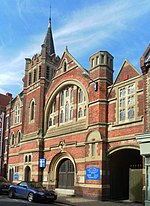The Saffrons
The Saffrons is a multi-purpose sports ground in Eastbourne, East Sussex. The ground is home to Eastbourne Cricket Club, Eastbourne Town Football Club, Eastbourne Hockey Club and Compton Croquet Club. There is also a sand dressed astroturf pitch. The sports ground is located on the edge of Eastbourne town centre, next to the town hall and is in easy reach of local transport links. The ground was first used in 1884. Sussex County Cricket Club played some of their matches there between 1896 and 2000, and recently from 2017. The complex has: A football pitch. Two cricket pitches, one of which is named Larkins field. An Astroturf Hockey pitch. A Croquet lawn. Sports bar and changing facilities.
Excerpt from the Wikipedia article The Saffrons (License: CC BY-SA 3.0, Authors).The Saffrons
Meads Road,
Geographical coordinates (GPS) Address Nearby Places Show on map
Geographical coordinates (GPS)
| Latitude | Longitude |
|---|---|
| N 50.766144 ° | E 0.276366 ° |
Address
Eastbourne Town Football Club
Meads Road
BN20 7DX , Meads
England, United Kingdom
Open on Google Maps








